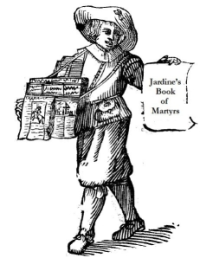The Killing of a Galloway Beggar in 1685: Who was it?
In his spiritual autobiography, James Nisbet claims that government troops ‘shot severals to death who’ had a ‘pass’ following the pressing of the Abjuration oath in early 1685. Among them was ‘a Beggar in Galloway’. There is no doubt that his description is vague. However, we have a location, ‘Galloway’, and some indication of social status, ‘a beggar’. Who was the Galloway beggar? …
 The Covenanter’s Grave at Kirkandrews © Colin Brown and licensed for reuse.
The Covenanter’s Grave at Kirkandrews © Colin Brown and licensed for reuse.
What follows is speculation on who the beggar was. A limited number of individuals were executed in the Killing Times, somewhere around eighty are recorded in the historical sources and a further twenty or so in traditions.
It is possible that Nisbet referred to a rumoured death that is not recorded in the historical sources. However, Nisbet did refer to two other named martyrs in the same section of his narrative. Did Nisbet refer to a recorded incident that we can trace? Perhaps, he did.
‘A beggar in Galloway’ may allude to one of the handful of single shootings in Galloway. If killings which are only recorded in later tradition (i.e., ahistorical events) and events involving the deaths of multiple Society people in Galloway are discounted, then there are four or five recorded candidates for the ‘beggar’.
Almost nothing is known about Alexander Linn who was killed in Kirkcowan parish. However, his death appears to be connected to others in the area and does not carry the same overtones of an innocent man killed that the death of a beggar carries.
Adam McQuhan is said to have been taken from his sick bed and shot at New Galloway. However, he appears to have been involved in the incident at Caldons.
The remaining two or three candidates are probably a better fit for the profile of a beggar, as they appear to have involved possible roadside misunderstandings with government forces which may have involved a beggar who held a pass.
‘——–‘ Auchinleck is said by Shields to have been a deaf man who was shot after he failed to answer questions. Whether he had a pass, or not, is not recorded. The framing of Shields’ brief narrative suggests that Auchinleck was an innocent man and therefore likely to have obtained a pass by taking the Abjuration. However, Wodrow’s later and not very credible version of events portrays Auchinleck as a man of some substance and does not mention that he was deaf.
Other good candidates for the beggar are Robert M’Whae and Mowat – M’Whae may be recorded by Shields as Mowat. Almost nothing is known about M’Whae except for the record of his gravestone which says that he was shot. Mowat was described as a tailor who was shot when he was discovered with the lead weights of his trade in Galloway.
Mowat, M’Whae and Auchinleck were all shot by Captain Thomas Douglas, who is alleged to have been quite careless in his choice of those executed. Neither Auchinleck, nor M’Whae/Mowat, appear to have been fugitives and may have held a pass from taking the Abjuration.
However, probably the best candidates for the Galloway beggar and the other two are the Carsgailoch Martyrs.
Text © Copyright Dr Mark Jardine. All Rights Reserved. Please link to or retweet this post, but do not reblog without the express permission of the author @drmarkjardine


[…] had died, rather than attempting to create a wider picture of the martyrs. With the exception of a beggar in Galloway and the boy near Cumnock, those he named were from his home area around Newmilns in Loudoun […]
Mysterys of the Carsgailoch Covenanters Shot in 1685 | Jardine's Book of Martyrs said this on February 26, 2014 at 4:25 pm |